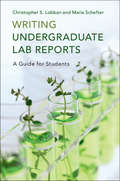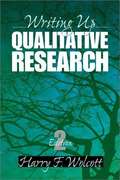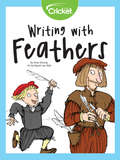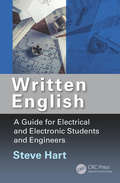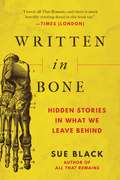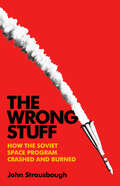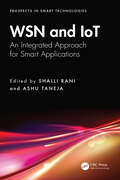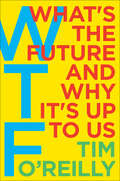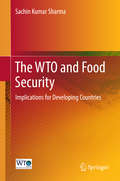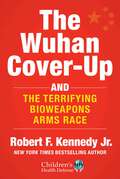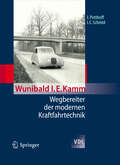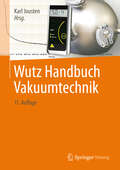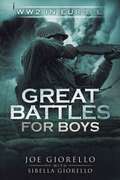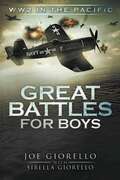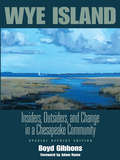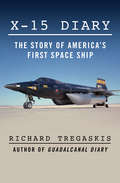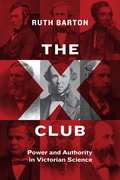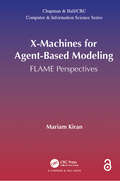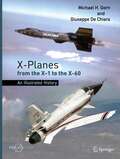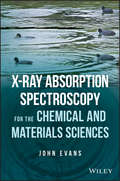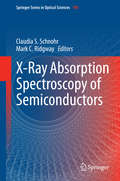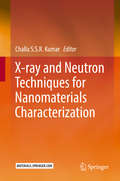- Table View
- List View
Writing Undergraduate Lab Reports: A Guide for Students
by Lobban Christopher S. María SchefterWriting clear, impactful reports is a crucial skill for science students, but few books focus on this area for the undergraduate. Particularly useful for biology students, this text adopts a hands-on approach, using example reports and published papers as models to put guidance into practice. An introductory chapter familiarizes undergraduates with the principles of writing science. Two model reports are then developed, walking students through experimental and observational teaching-lab reports. The structure and content of the Introduction, Methods and Materials, Results, and Discussion are explained, together with tips for the title, abstract, and references. Students are then guided on how to polish their first draft. The last section of the book analyzes two published papers, helping the reader transition to reporting original research. Clearly and concisely written, this text offers a much-needed lifeline for science students facing science report-writing for the first time, and for those looking to hone their writing skills.
Writing Up Qualitative Research
by Harry F. WolcottThis author provides practical advice on how to write up research results gleaned from qualitative studies.
Writing with Feathers
by Rupert Van Wyk Anne RooneyWriting is very important to all of us! But did you know that people in the past did not have the same kind of writing instrument that we use today? Instead of using plastic or metals to create pens, people in the past used feathers to create pens! This story gives a brief history of what people used to write with and how they eventually developed the feather pen! Not only will you have a history of writing, but you will also learn how to create your very own feather pen!
Written English: A Guide for Electrical and Electronic Students and Engineers
by Steve HartA research paper or graduate essay demonstrating weak English and poor formatting is likely to be rejected by an editor or marked down by an assessor; but why should these gaps in your English knowledge undermine your subject knowledge and skill as an engineer or student of the discipline? Written English: A Guide for Electrical and Electronic Students and Engineers is the first resource to work at the sentence level to resolve the English language problems facing international engineering students and scholars. Informed by hundreds of research papers and student essays, this valuable reference: Covers grammar essentials and key terms in the fields of electrical engineering, electronic engineering, and communication systems Uses real-world examples to reveal common mistakes and identify critical areas of focus Provides practical solutions to formatting, vocabulary, and stylistic issues Written English: A Guide for Electrical and Electronic Students and Engineers equips readers with the necessary knowledge to produce accurate and effective English when writing for engineering.
Written in Bone: Hidden Stories in What We Leave Behind
by Sue BlackFrom the author of All That Remains, a tour through the human skeleton and the secrets our bones reveal. Longlisted for the Crime Writers&’ Association ALCS Gold Dagger for Nonfiction. In her memoir All That Remains, internationally renowned forensic anthropologist and human anatomist Dame Sue Black recounted her life lived eye to eye with the Grim Reaper. During the course of it, she offered a primer on the basics of identifying human remains, plenty of insights into the fascinating processes of death, and a sober, compassionate understanding of its inescapable presence in our existence, all leavened with her wicked sense of humor. In her new book, Sue Black builds on the first, taking us on a guided tour of the human skeleton and explaining how each person's life history is revealed in their bones, which she calls "the last sentinels of our mortal life to bear witness to the way we lived it." Her narrative follows the skeleton from the top of the skull to the small bones in the foot. Each step of the journey includes an explanation of the biology—how the bone is formed in a person's development, how it changes as we age, the secrets it may hold—and is illustrated with anecdotes from the author's career helping solve crimes and identifying human remains, whether recent or historical. Written in Bone is full of entertaining stories that read like scenes from a true-life CSI drama, infused with humor and no-nonsense practicality about the realities of corpses and death.
The Wrong Stuff: How the Soviet Space Program Crashed and Burned
by John StrausbaughA witty, deeply researched history of the surprisingly ramshackle Soviet space program, and how its success was more spin than science. In the wake of World War II, with America ascendant and the Soviet Union devastated by the conflict, the Space Race should have been over before it started. But the underdog Soviets scored a series of victories--starting with the 1957 launch of Sputnik and continuing in the years following--that seemed to achieve the impossible. It was proof, it seemed, that the USSR had manpower and collective will that went beyond America's material advantages. They had asserted themselves as a world power. But in The Wrong Stuff, John Strausbaugh tells a different story. These achievements were amazing, yes, but they were also PR victories as much as scientific ones. The world saw a Potemkin spaceport; the internal facts were much sloppier, less impressive, more dysfunctional. The Soviet supply chain was a disaster, and many of its machines barely worked. The cosmonauts aboard its iconic launch of the Vostok 1 rocket had to go on a special diet, and take off their space suits, just to fit inside without causing a failure. Soviet scientists, under intense government pressure, had essentially made their rocket out of spit and band aids, and hurried to hide their work as soon as their worldwide demonstration was complete. With a witty eye for detail and a gift for storytelling, John Strausbaugh takes us behind the Iron Curtain, and shows just how little there was to find there.
WSN and IoT: An Integrated Approach for Smart Applications (Prospects in Smart Technologies)
by Shalli Rani Ashu TanejaNowadays, all of us are connected through a large number of sensor nodes, smart devices, and wireless terminals. For these Internet of Things (IoT) devices to operate seamlessly, the Wireless Sensor Network (WSN) needs to be robust to support huge volumes of data for information exchange, resource optimization, and energy efficiency. This book provides in-depth information about the emerging paradigms of IoT and WSN in new communication scenarios for energy-efficient and reliable information exchange between a large number of sensor nodes and applications.WSN and IoT: An Integrated Approach for Smart Applications discusses how the integration of IoT and WSN enables an efficient communication flow between sensor nodes and wireless terminals and covers the role of machine learning (ML), artificial intelligence (AI), deep learning (DL), and blockchain technologies which give way to intelligent networks. This book presents how technological advancement is beneficial for real-time applications involving a massive number of devices and discusses how the network carries huge amounts of data allowing information to be communicated over the Internet. Intelligent transportation involving connected vehicles and roadside units is highlighted to show how a reality created through the intelligent integration of IoT and WSN is possible. Convergence is discussed and its use in smart healthcare, where only through the intelligent connection of devices can patients be treated or monitored remotely for telemedicine or telesurgery applications. This book also looks at how sustainable development is achieved by the resource control mechanism enabling energy-efficient communication.A wide range of communication paradigms related to smart cities, which includes smart healthcare, smart transportation, smart homes, and intelligent data processing, are covered in the book. It is aimed at academicians, researchers, advanced-level students, and engineers who are interested in the advancements of IoT and WSN for various applications in smart cities.
WTF?: What's the Future and Why It's Up to Us
by Tim O'ReillyWTF? can be an expression of amazement or an expression of dismay. In today’s economy, we have far too much dismay along with our amazement, and technology bears some of the blame. In this combination of memoir, business strategy guide, and call to action, Tim O'Reilly, Silicon Valley’s leading intellectual and the founder of O’Reilly Media, explores the upside and the potential downsides of today's WTF? technologies. What is the future when an increasing number of jobs can be performed by intelligent machines instead of people, or done only by people in partnership with those machines? What happens to our consumer based societies—to workers and to the companies that depend on their purchasing power? Is income inequality and unemployment an inevitable consequence of technological advancement, or are there paths to a better future? What will happen to business when technology-enabled networks and marketplaces are better at deploying talent than traditional companies? How should companies organize themselves to take advantage of these new tools? What’s the future of education when on-demand learning outperforms traditional institutions? How can individuals continue to adapt and retrain? Will the fundamental social safety nets of the developed world survive the transition, and if not, what will replace them? O'Reilly is "the man who can really can make a whole industry happen," according to Eric Schmidt, Executive Chairman of Alphabet (Google.) His genius over the past four decades has been to identify and to help shape our response to emerging technologies with world shaking potential—the World Wide Web, Open Source Software, Web 2.0, Open Government data, the Maker Movement, Big Data, and now AI. O’Reilly shares the techniques he's used at O’Reilly Media to make sense of and predict past innovation waves and applies those same techniques to provide a framework for thinking about how today’s world-spanning platforms and networks, on-demand services, and artificial intelligence are changing the nature of business, education, government, financial markets, and the economy as a whole. He provides tools for understanding how all the parts of modern digital businesses work together to create marketplace advantage and customer value, and why ultimately, they cannot succeed unless their ecosystem succeeds along with them.The core of the book's call to action is an exhortation to businesses to DO MORE with technology rather than just using it to cut costs and enrich their shareholders. Robots are going to take our jobs, they say. O'Reilly replies, “Only if that’s what we ask them to do! Technology is the solution to human problems, and we won’t run out of work till we run out of problems." Entrepreneurs need to set their sights on how they can use big data, sensors, and AI to create amazing human experiences and the economy of the future, making us all richer in the same way the tools of the first industrial revolution did. Yes, technology can eliminate labor and make things cheaper, but at its best, we use it to do things that were previously unimaginable! What is our poverty of imagination? What are the entrepreneurial leaps that will allow us to use the technology of today to build a better future, not just a more efficient one? Whether technology brings the WTF? of wonder or the WTF? of dismay isn't inevitable. It's up to us!
The WTO and Food Security
by Sachin Kumar SharmaThis book examines the public stockholding policies of selected developing countries from the perspective of WTO rules and assesses whether the provisions of the Agreement on Agriculture (AoA) could hamper these countries' efforts to address the challenges of food security. Further, it highlights the need to amend the provisions of the AoA to make WTO rules just and fair for the millions of people suffering from hunger and malnutrition in developing countries. This book highlights that 12 countries namely China, Egypt, India, Indonesia, Jordan, Kenya, Morocco, Pakistan, Tunisia, Turkey, Zambia and Zimbabwe are facing or will face problems in implementing the food security policies due to the provisions under AoA. These provisions need to be amended for permitting developing countries to address hunger and undernourishment. Progress in WTO negotiations on public stockholding for food security purposes are also discussed and analysed. The findings of this study greatly benefit trade negotiators, policymakers, civil society, farmers groups, researchers, students and academics interested in issues related to the WTO, agriculture and food security.
The Wuhan Cover-Up: And the Terrifying Bioweapons Arms Race (Children’s Health Defense)
by Robert F. Kennedy Jr.&“RFK Jr. exposes the decades of lies.&”—Luc Montagnier, Nobel laureate From the New York Times, Wall Street Journal, USA Today, and Publishers Weekly bestselling author of The Real Anthony Fauci comes an explosive exposé of the cover-up behind the true origins of COVID-19. &“Gain-of-function&” experiments are often conducted to deliberately develop highly virulent, easily transmissible pathogens for the stated purpose of developing preemptive vaccines for animal viruses before they jump to humans. More insidious is the &“dual use&” nature of this research, specifically directed toward bioweapons development. The Wuhan Cover-Up pulls back the curtain on how the US government's increase in biosecurity spending after the 2001 terror attacks set in motion a plan to transform the National Institute of Allergy and Infectious Diseases (NIAID), under the direction of Dr. Anthony Fauci, into a de facto Defense Department agency. While Dr. Fauci zealously funded and pursued gain-of-function research, concern grew among some scientists and government officials about the potential for accidental or deliberate release of weaponized viruses from labs that might trigger worldwide pandemics. A moratorium was placed on this research, but true to form, Dr. Fauci found ways to continue unperturbed—outsourcing some of the most controversial experiments offshore to China and providing federal funding to Wuhan Institute of Virology's (WIV's) leading researchers for gain-of-function studies in partnership with the Chinese military and the Chinese Communist Party. Robert F. Kennedy Jr.'s meticulously researched and rigorously sourced analysis leads readers on a staggering journey to learn about: the key enablers and henchmen pushing for gain-of-function research the economic motives behind gain-of-function research successfully engineered &“chimeric viruses&” that can infect and kill humans the coordinated effort to silence speculation of COVID-19&’s laboratory genesis the complicity of scientific journals to hide the origins of COVID-19 the role of the Wuhan Institute of Virology in China&’s biowarfare/biodefense program the relationships between US health, military, and intelligence bureaucracies and scientists and their Chinese counterparts the roles of Bill Gates and Sir Jeremy Farrar in orchestrating a global cover-up The Wuhan Cover-Up unveils a global conspiracy of epic proportion and lethal consequence.
Wunibald I. E. Kamm - Wegbereiter der modernen Kraftfahrtechnik
by Ingobert C. Schmid Jürgen PotthoffDie "Kammsche Regel" zur Verbesserung der Richtungsstabilität oder das K-Heck, das sich in der Form vieler moderner Pkws verbirgt - diese und viele andere innovativen Konzepte gehen auf Professor Kamm (1893 - 1966) zurück, den Begründer der wissenschaftlichen Grundlagen der Kfz-Technik. Leben und Wirken des deutschen Automobil-Wissenschaftlers werden in dieser Monografie analysiert und seine Rolle während des Nationalsozialismus neu beleuchtet. 2009 wurde Wunibald I. E. Kamm posthum mit der Aufnahme in die "Automotive Hall of Fame" der USA geehrt.
Wutz Handbuch Vakuumtechnik: Theorie Und Praxis
by Karl Jousten Wolfgang Jitschin Felix Sharipov Rudolf Lachenmann Alfons Jünemann Uwe Friedrichsen Erik Lippelt Boris Kossek Harald Grave Klaus Galda Frank Leiter Christian Day Norbert Müller Robert Ellefson Werner Große Bley Markus Veldkamp Uwe Meißner Bernhard SchimunekDieses Standardwerk gibt dem Leser umfassend Auskunft über Theorie und Praxis der Vakuumtechnik. Eine große Anzahl von numerischen Beispielen sowie aussagekräftigen Abbildungen erläutert und visualisiert überzeugend die theoretischen Sachverhalte. In der aktuellen Auflage wurde im Kapitel 12 das Pulsrohrverfahren aufgenommen sowie die Abschnitte Kryokondensation und Kryotrapping aktualisiert. Das Kapitel Vakuumsysteme wurde um zwei Abschnitte Berechnung und Druckregelung ergänzt.
WW2 in Europe (Great Battles for Boys)
by Joe Giorello Sibella GiorelloBeginning with Hitler's invasion of Poland, Great Battles for Boys: WW2 Europe takes young readers to the front lines of the war’s most important clashes. Boys will discover the raw history of warfare and learn the battles in chronological order. From Stalingrad’s hand-to-hand street fighting and the world's largest tank action at Kursk to the spy-led invasion of Sicily and the surprise D-Day invasion of Normandy—and many other exciting battles!
WW2 in the Pacific (Great Battles for Boys)
by Joe Giorello Sibella GiorelloGreat Battles for Boys takes young readers to the front lines of history's most important fights. In this episode of the best-selling history series, the story opens with the Flying Tigers, those wild American soldiers fighting Japan before the bombing of Pearl Harbor. After the deadly surprise attack on Hawaii, the battles storm across the Pacific in the lethal "island hopping" military strategy that brought Victory Over Japan.
Wye Island: Insiders, Outsiders, and Change in a Chesapeake Community - Special Reprint Edition
by Boyd GibbonsToday, most of the 2,800 tranquil acres that make up Wye Island are managed by the Maryland Park Service. However, from 1973 to 1974, the island was the site of a raging controversy. A major developer, James Rouse, wanted to build a compact waterfront village that would be surrounded by large estates, protected farms, and wetlands. A boyhood resident of nearby Easton, Maryland, Rouse hoped that the island could avoid the sprawl of unplanned subdivisions that were marring so many other places along the Eastern Shore. Combining history, journalism, character sketches, and sharp sociological insight, Boyd Gibbons presents the conflict over Wye Island in its multiple dimensions - as an example of the emerging community-based activism of the 1960s and 70s, and of a community that, while exercising its right to preserve its identity, denies opportunities for its members to improve their lives through change. In fact, Wye Island proves not to be the environmental David-Goliath struggle that might be expected. For one thing, residents opposed a development plan that can be regarded as an early model for 'smart growth.' And many were no more favorably disposed to a park or preserve than to a planned village. Their interest was in protecting the community from an invasion of immigrants from ethnically diverse Baltimore and Washington, and, where the wealthy were concerned, protecting some very private views of the water. In the end, rich landowners, poor 'natives,' and many recent newcomers opposed the Rouse project - distrusting change, and, above all, fearing 'outsiders.' The special reprint of Wye Island includes a new foreword by distinguished environmental historian Adam Rome, who explores the enduring themes of Wye Island in context of the current debates about land use, development, and sprawl.
WYXIE Wonderland: An Unauthorized 50-Year Diary of WXYZ Detroit
by Dick OsgoodWYXIE WONDERLAND, by Dick Osgood, is a good time and more than that. Here is possibly the first comprehensive exploration into the inner workings of a broadcasting enterprise. It is as broad as it is deep, revealing the secrets of top management as completely as--perhaps even more fully than--it does the vagaries of performing talent. It is not a purely local story. Fifty years of national radio and television history--1925-1975--are reflected in the fundamental and accidental specifics of a single station--WXYZ, Detroit-AM, FM and TV. This is the diary of that station, unauthorized and independently written. WYXIE WONDERLAND was much more than the birthplace of The Lone Ranger, The Green Hornet and Sergeant Preston of the Yukon. It was the starting point of SOUPY SALES and MIKE WALLACE, of DOUGLAS EDWARDS and JOHN HODIAK, of GEORGE SEATON, MARTHA SCOTT and DANNY THOMAS. Here are the hilarious fluffs, minor on-the-air disasters and a phantom broadcast. This extraordinary book traces the beginnings of five networks; it follows the rise and decline of radio network programming. It sees the radio actor replaced by--the disc jockey. There are record hops with FABIAN, CHUCK BERRY and STEVIE WONDER. WYXIE WONDERLAND explains how the scandal of radio payola grew out of the discovery of rigged TV quiz programs. It tells of a sound created in Texas that revolutionized radio, and how the Top 40 format emerged from a bar in Omaha. The confusion of early television is in it as well as of early radio, and the nefarious underground beginnings of FM. Alcoholism is discovered to be something of an occupational disease. The infighting among stations and executives for ratings, accounts and position gets tough. Personalities clash. There are victories and surprising defeats.
X: The Foghorn Decision
by Robert S. Huckman Karim R. Lakhani Kyle R. Myers"As she settled into her seat for her flight from Copenhagen back to San Francisco, Kathy Hannun reflected on her meetings earlier in the week with several of the world’s leading experts in solid oxide electrolyzer cell (SOEC) technology. It was February 2016, and it had been nearly three years since she began leading the team at X – Alphabet Inc.’s so-called “moonshot factory” to develop radical solutions to major problems – working to turn sea water into fuel."
X-15 Diary: The Story of America's First Space Ship
by Richard TregaskisThe riveting true story of the world's fastest plane and the first manned flights into outer space. First tested in 1959, the X-15 rocket plane was at the forefront of the space race. Developed by the US Air Force and the National Aeronautics and Space Administration (NASA) in collaboration with North American Aviation, the X-15 was sleek, black, and powerful--a missile with stubby wings and a cockpit on the nose. By 1961 it could reach speeds over three thousand miles per hour and fly at an altitude of thirty-one miles above the earth's surface--the lower reaches of outer space. Acclaimed journalist and bestselling author Richard Tregaskis tells the story of the X-15's development through the eyes of the brave pilots and brilliant engineers who made it possible. From technological breakthroughs to disastrous onboard explosions to the bone-crushing effects of intense g-force levels, Tregaskis captures all the drama and excitement of this crucial proving ground for the Mercury, Gemini, and Apollo missions. X-15 Diary recounts a thrilling chapter in the history of the American space program and serves as a fitting tribute to the courageous scientists and adventurers who dared to go where no man had gone before. This ebook features an illustrated biography of Richard Tregaskis including rare images from the American Heritage Center at the University of Wyoming.
The X Club: Power and Authority in Victorian Science
by Ruth BartonIn 1864, amid headline-grabbing heresy trials, members of the British Association for the Advancement of Science were asked to sign a declaration affirming that science and scripture were in agreement. Many criticized the new test of orthodoxy; nine decided that collaborative action was required. The X Club tells their story. These six ambitious professionals and three wealthy amateurs—J. D. Hooker, T. H. Huxley, John Tyndall, John Lubbock, William Spottiswoode, Edward Frankland, George Busk, T. A. Hirst, and Herbert Spencer—wanted to guide the development of science and public opinion on issues where science impinged on daily life, religious belief, and politics. They formed a private dining club, which they named the X Club, to discuss and further their plans. As Ruth Barton shows, they had a clear objective: they wanted to promote “scientific habits of mind,” which they sought to do through lectures, journalism, and science education. They devoted enormous effort to the expansion of science education, with real, but mixed, success. For twenty years, the X Club was the most powerful network in Victorian science—the men succeeded each other in the presidency of the Royal Society for a dozen years. Barton’s group biography traces the roots of their success and the lasting effects of their championing of science against those who attempted to limit or control it, along the way shedding light on the social organization of science, the interactions of science and the state, and the places of science and scientific men in elite culture in the Victorian era.
X-Machines for Agent-Based Modeling: FLAME Perspectives (Chapman & Hall/CRC Computer and Information Science Series)
by Mariam KiranFrom the Foreword: "This book exemplifies one of the most successful approaches to modeling and simulating [the] new generation of complex systems. FLAME was designed to make the building of large scale complex systems models straightforward and the simulation code that it generates is highly efficient and can be run on any modern technology. FLAME was the first such platform that ran efficiently on high performance parallel computers and a version for GPU technology is also available. At its heart, and the reason why it is so efficient and robust, is the use of a powerful computational model ‘Communicating X-machines’ which is general enough to cope with most types of modelling problems. As well as being increasingly important in academic research, FLAME is now being applied in industry in many different application areas. This book describes the basics of FLAME and is illustrated with numerous examples."—Professor Mike Holcombe, University of Sheffield, UK Agent-based models have shown applications in various fields such as biology, economics, and social science. Over the years, multiple agent-based modeling frameworks have been produced, allowing experts with non-computing background to easily write and simulate their models. However, most of these models are limited by the capability of the framework, the time it takes for a simulation to finish, or how to handle the massive amounts of data produced. FLAME (Flexible Large-scale Agent-based Modeling Environment) was produced and developed through the years to address these issues. This book contains a comprehensive summary of the field, covers the basics of FLAME, and shows how concepts of X-machines, can be stretched across multiple fields to produce agent models. It has been written with several audiences in mind. First, it is organized as a collection of models, with detailed descriptions of how models can be designed, especially for beginners. A number of theoretical aspects of software engineering and how they relate to agent-based models are discussed for students interested in software engineering and parallel computing. Finally, it is intended as a guide to developers from biology, economics, and social science, who want to explore how to write agent-based models for their research area. By working through the model examples provided, anyone should be able to design and build agent-based models and deploy them. With FLAME, they can easily increase the agent number and run models on parallel computers, in order to save on simulation complexity and waiting time for results. Because the field is so large and active, the book does not aim to cover all aspects of agent-based modeling and its research challenges. The models are presented to show researchers how they can build complex agent functions for their models. The book demonstrates the advantage of using agent-based models in simulation experiments, providing a case to move away from differential equations and build more reliable, close to real, models. The Open Access version of this book, available at https://doi.org/10.1201/9781315370729, has been made available under a Creative Commons Attribution-Non Commercial-No Derivatives 4.0 license.
X-Parameters
by David E. Root Jan Verspecht Jason Horn Mihai Marcu David E. Root Jan Verspecht Jason HornThis is the definitive guide to X-parameters, written by the original inventors and developers of this powerful new paradigm for nonlinear RF and microwave components and systems. Learn how to use X-parameters to overcome intricate problems in nonlinear RF and microwave engineering. The general theory behind X-parameters is carefully and intuitively introduced, and then simplified down to specific, practical cases, providing you with useful approximations that will greatly reduce the complexity of measuring, modeling and designing for nonlinear regimes of operation. Containing real-world case studies, definitions of standard symbols and notation, detailed derivations within the appendices, and exercises with solutions, this is the definitive stand-alone reference for researchers, engineers, scientists and students looking to remain on the cutting-edge of RF and microwave engineering.
X-Planes from the X-1 to the X-60: An Illustrated History (Springer Praxis Books)
by Michael H. Gorn Giuseppe De ChiaraForeword by Dr. Roger D. Launius, Former NASA Chief Historian For the past 75 years, the U.S. government has invested significant time and money into advanced aerospace research, as evidenced by its many experimental X-plane aircraft and rockets. NASA's X-Planes asks a simple question: What have we gained from it all? To answer this question, the authors provide a comprehensive overview of the X-plane’s long history, from the 1946 X-1 to the modern X-60. The chapters describe not just the technological evolution of these models, but also the wider story of politics, federal budgets, and inter-agency rivalries surrounding them. The book is organized into two sections, with the first covering the operational X-planes that symbolized the Cold War struggle between the U.S. and the U.S.S.R, and the second section surveying post-Cold War aircraft and spacecraft. Featuring dozens of original illustrations of X-plane cross-sections, in-flight profiles, close-ups, and more, this book will educate general readers and specialists alike.
X-ray Absorption Spectroscopy for the Chemical and Materials Sciences
by John EvansA clear-cut introduction to the technique and applications of x-ray absorption spectroscopy X-ray Absorption Spectroscopy is being applied to a widening set of disciplines. Applications started with solid state physics and grew to materials science, chemistry, biochemistry and geology. Now, they cut across engineering materials, environmental science and national heritage — providing very detailed and useful information facilitating understanding and development of materials. This practical guide helps investigators choose the right experiment, carry it out properly and analyze the data to give the best reliable result. It gives readers insights to extract what they need from the world of large-scale experimental facilities like synchrotrons, which seem distant to many laboratory scientists. X-ray Absorption Spectroscopy for the Chemical and Materials Sciences seeks to educate readers about the strengths and limitations of the techniques, including their accessibility. Presented in six sections, it offers chapters that cover: an introduction to X-ray absorption fine structure XAFS; the basis of XAFS; X-ray sources; experimental methods; data analysis and simulation methods; and case studies. A no-nonsense introduction to the technique and applications of x-ray absorption spectroscopy Features Questions to support learning through the book Relevant to all working on synchrotron sources and applications in physics, materials, environment/geology and biomedical materials Four-color representation allows easy interpretation of images and data for the reader X-ray Absorption Spectroscopy for the Chemical and Materials Sciences is aimed at Masters-level and PhD students embarking on X-ray spectroscopy projects as well as scientists in areas of materials characterization.
X-Ray Absorption Spectroscopy of Semiconductors
by Claudia S. Schnohr Mark C. RidgwayX-ray Absorption Spectroscopy (XAS) is a powerful technique with which to probe the properties of matter, equally applicable to the solid, liquid and gas phases. Semiconductors are arguably our most technologically-relevant group of materials given they form the basis of the electronic and photonic devices that now so widely permeate almost every aspect of our society. The most effective utilisation of these materials today and tomorrow necessitates a detailed knowledge of their structural and vibrational properties. Through a series of comprehensive reviews, this book demonstrates the versatility of XAS for semiconductor materials analysis and presents important research activities in this ever growing field. A short introduction of the technique, aimed primarily at XAS newcomers, is followed by twenty independent chapters dedicated to distinct groups of materials. Topics span dopants in crystalline semiconductors and disorder in amorphous semiconductors to alloys and nanometric material as well as in-situ measurements of the effects of temperature and pressure. Summarizing research in their respective fields, the authors highlight important experimental findings and demonstrate the capabilities and applications of the XAS technique. This book provides a comprehensive review and valuable reference guide for both XAS newcomers and experts involved in semiconductor materials research.
X-ray and Neutron Techniques for Nanomaterials Characterization
by Challa S. S. R. KumarFifth volume of a 40 volume series on nanoscience and nanotechnology, edited by the renowned scientist Challa S. S. R. Kumar. This handbook gives a comprehensive overview about X-ray and Neutron Techniques for Nanomaterials Characterization. Modern applications and state-of-the-art techniques are covered and make this volume an essential reading for research scientists in academia and industry.
